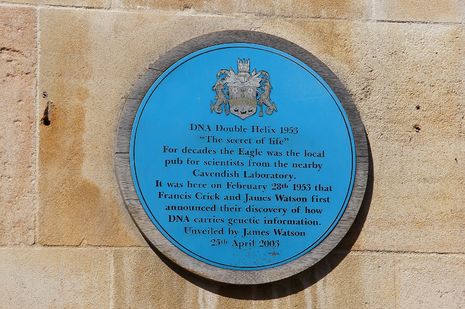Replacement plaque celebrates Rosalind Franklin’s DNA role
The new plaque replaces an original outside The Eagle pub, which had only featured the names of Watson and Crick

Seventy years after they played a vital role in unravelling the double helix structure of DNA, the names of Rosalind Franklin and Maurice Wilkins have finally appeared on a new blue plaque marking Watson and Crick’s announcement of the discovery of DNA in The Eagle pub.
The new plaque, which states that the breakthrough “relied on data from Rosalind Franklin, Maurice Wilkins and other scientists”, was unveiled last Wednesday (30/08) by Christopher Howe, deputy Master of Corpus Christi College. It replaces an older plaque that failed to acknowledge the contributions of other researchers.
Franklin, an alumna of Newnham college, identified errors in Watson and Crick’s first attempt to model DNA in 1951, and her unpublished data, passed to the duo without her knowledge by Max Perutz, was crucial in confirming their findings.
Photo 51, one of many X-ray diffraction images of DNA produced by Franklin and her PhD student Raymond Gosling in the lab, was shared with Watson by Wilkins, giving him an important insight into DNA’s helical structure.
While Watson, Crick and Wilkins won Nobel Prizes for their work in 1962 – the first two even becoming synonymous with DNA itself – Franklin died prematurely from ovarian cancer in 1958, failing to receive credit for her work.
The replacement plaque comes six years after an unknown graffitist wrote “+ Franklin” on the original plaque, protesting the omission.
Penny Heath, chair of the Cambridge Blue Plaque Committee, said: “In recent years there have been efforts to increase awareness of the role played by important female scientists, whose work has sometimes been overshadowed by their male colleagues.”
“Rosalind Franklin was one such scientist and so the DNA plaque without her name became emblematic of this cause,” she continued.
Heath added that replacing the plaque provides “the opportunity to recognise the work of Franklin, Maurice Wilkins and others, as well as that of Crick and Watson.”
At the unveiling, biochemistry expert Professor Howe said: “The College is delighted that the new plaque gives better recognition to those other pioneering scientists whose work was essential to this important discovery.”
“It is especially gratifying to see the recognition of an important female scientist, as this year we are also celebrating the 40th anniversary of female undergraduates at Corpus,” Howe continued.
Recent years have seen growing interest in Rosalind Franklin and her work. Numerous prizes, events and locations worldwide all bear her name, including an accommodation building in Newnham. In 2013, The Eagle marked the 60th anniversary of the announcement of the discovery of DNA by installing a gold plaque honouring Franklin below another gold plaque for Watson and Crick.
Literary retellings have also brought awareness to Franklin’s works, like Anna Ziegler’s play “Photograph 51”, starring Nicole Kidman in its 2015 West End run, and the musical “Double Helix”, which premièred at Bay Street Theatre on Long Island this May.
 News / Cambridge student numbers fall amid nationwide decline14 April 2025
News / Cambridge student numbers fall amid nationwide decline14 April 2025 Lifestyle / First year, take two: returning after intermission14 April 2025
Lifestyle / First year, take two: returning after intermission14 April 2025 News / Greenwich House occupiers miss deadline to respond to University legal action15 April 2025
News / Greenwich House occupiers miss deadline to respond to University legal action15 April 2025 Comment / The Cambridge workload prioritises quantity over quality 16 April 2025
Comment / The Cambridge workload prioritises quantity over quality 16 April 2025 Sport / Cambridge celebrate clean sweep at Boat Race 202514 April 2025
Sport / Cambridge celebrate clean sweep at Boat Race 202514 April 2025





